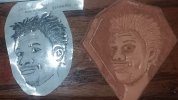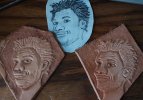- Joined
- Sep 21, 2014
- Messages
- 2,821
Hello all. I hope everyone is still staying safe and healthy.
This isn't necessarily sheath related, but may be applicable in the future. Also, I'm going to ask that the Moderators immediately delete any comments about anyone's opinions on the subject matter.
Having said that, after seeing my carving of Bear, my sister asked me if I could do a picture for her to put in her window to show her support for the black lives matter and police shootings protests. We came up with the idea of some sort of collage of victims of police shootings. So I did a few sketches and tried one on a piece of scrap. This face is about 2 1/2" tall.

My main question for the masters is would you use a round knife cut in any of the face details? Or just the outline to help separate it from the background? You can probably see where I cut in the eyes, lips, forehead, nose and ear. Because these lines are visible, I'm thinking that I could just use a thin modelling tool instead.
Also, any tips on doing pupils?
And should I make this 2-toned, using only black and brown/tan dyes or keep is monotone, with varying shades of brown?
Any other suggestions?
Thank you.
This isn't necessarily sheath related, but may be applicable in the future. Also, I'm going to ask that the Moderators immediately delete any comments about anyone's opinions on the subject matter.
Having said that, after seeing my carving of Bear, my sister asked me if I could do a picture for her to put in her window to show her support for the black lives matter and police shootings protests. We came up with the idea of some sort of collage of victims of police shootings. So I did a few sketches and tried one on a piece of scrap. This face is about 2 1/2" tall.

My main question for the masters is would you use a round knife cut in any of the face details? Or just the outline to help separate it from the background? You can probably see where I cut in the eyes, lips, forehead, nose and ear. Because these lines are visible, I'm thinking that I could just use a thin modelling tool instead.
Also, any tips on doing pupils?
And should I make this 2-toned, using only black and brown/tan dyes or keep is monotone, with varying shades of brown?
Any other suggestions?
Thank you.



